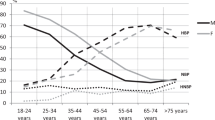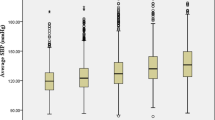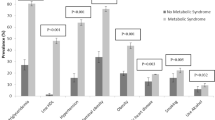Abstract
Elevated blood pressure (BP) may lead to incident diabetes. However, data about the effect of different BP components on incident diabetes in Middle Eastern women is lacking. We evaluated systolic BP (SBP), diastolic BP (DBP), pulse pressure (PP) and mean arterial pressure (MAP) as independent predictors of diabetes in Iranian women. We performed a population-based prospective study among 3028 non-diabetic women, aged ⩾20 years. Odds ratios (ORs) of diabetes were calculated for every 1 s.d. increase in SBP, DBP, PP and MAP. During ≈6 years of follow-up, 220 women developed diabetes. There were significant interactions between family history of diabetes and SBP, PP and MAP (P⩽0.01) in predicting incident diabetes. In women without a family history of diabetes, all BP components were significantly associated with diabetes in the age-adjusted model; the risk factor-adjusted ORs were significant (P<0.05) for SBP, PP and MAP (1.30, 1.34 and 1.27, respectively) with similar predictive ability (area under the receiver operating characteristic curve ≈83%). In women with family history of diabetes, in the age-adjusted model, SBP, DBP and MAP were associated with diabetes; in multivariable model, they were not independent predictors of diabetes. In conclusion, in women without family history of diabetes, SBP, PP and MAP, were independent predictors of diabetes with almost similar predictive ability; hence, in the evaluation of the risk of BP components for prediction of diabetes, the presence of family history of diabetes should be considered.
This is a preview of subscription content, access via your institution
Access options
Subscribe to this journal
Receive 12 digital issues and online access to articles
$119.00 per year
only $9.92 per issue
Buy this article
- Purchase on Springer Link
- Instant access to full article PDF
Prices may be subject to local taxes which are calculated during checkout

Similar content being viewed by others
References
Zimmet P, Alberti KG, Shaw J . Global and societal implications of the diabetes epidemic. Nature 2001; 414: 782–787.
Wild S, Roglic G, Green A, Sicree R, King H . Global prevalence of diabetes: estimates for the year 2000 and projections for 2030. Diabetes Care 2004; 27: 1047–1053.
Hadaegh F, Bozorgmanesh MR, Ghasemi A, Harati H, Saadat N, Azizi F . High prevalence of undiagnosed diabetes and abnormal glucose tolerance in the Iranian urban population: Tehran Lipid and Glucose Study. BMC Public Health 2008; 8: 176.
Harati H, Hadaegh F, Saadat N, Azizi F . Population-based incidence of type 2 diabetes and its associated risk factors: results from a six-year cohort study in Iran. BMC Public Health 2009; 9: 186.
Alberti KG, Zimmet P, Shaw J . International Diabetes Federation: a consensus on type 2 diabetes prevention. Diabet Med 2007; 24: 451–463.
Knowler WC, Barrett-Connor E, Fowler SE, Hamman RF, Lachin JM, Walker EA et al. Reduction in the incidence of type 2 diabetes with lifestyle intervention or metformin. N Engl J Med 2002; 346: 393–403.
Dotevall A, Johansson S, Wilhelmsen L, Rosengren A . Increased levels of triglycerides, BMI and blood pressure and low physical activity increase the risk of diabetes in Swedish women. A prospective 18-year follow-up of the BEDA study. Diabet Med 2004; 21: 615–622.
Golden SH, Wang NY, Klag MJ, Meoni LA, Brancati FL . Blood pressure in young adulthood and the risk of type 2 diabetes in middle age. Diabetes Care 2003; 26: 1110–1115.
Hayashi T, Tsumura K, Suematsu C, Endo G, Fujii S, Okada K . High normal blood pressure, hypertension, and the risk of type 2 diabetes in Japanese men. The Osaka Health Survey. Diabetes Care 1999; 22: 1683–1687.
Stern MP . Diabetes and cardiovascular disease. The ‘common soil’ hypothesis. Diabetes 1995; 44: 369–374.
Julius S, Gudbrandsson T, Jamerson K, Tariq Shahab S, Andersson O . The hemodynamic link between insulin resistance and hypertension. J Hypertens 1991; 9: 983–986.
Conen D, Ridker PM, Mora S, Buring JE, Glynn RJ . Blood pressure and risk of developing type 2 diabetes mellitus: the Women's Health Study. Eur Heart J 2007; 28: 2937–2943.
Azizi F, Rahmani M, Emami H, Madjid M . Tehran Lipid and Glucose Study: rationale and design. CVD Prevention 2000; 3: 242–247.
Azizi F, Ghanbarian A, Momenan AA, Hadaegh F, Mirmiran P, Hedayati M . Prevention of non-communicable disease in a population in nutrition transition: Tehran Lipid and Glucose Study phase II. Trials 2009; 10: 5.
Genuth S, Alberti KG, Bennett P, Buse J, Defronzo R, Kahn R et al. Follow-up report on the diagnosis of diabetes mellitus. Diabetes Care 2003; 26: 3160–3167.
Chobanian AV, Bakris GL, Black HR, Cushman WC, Green LA, Izzo JL et al. The Seventh Report of the Joint National Committee on Prevention, Detection, Evaluation, and Treatment of High Blood Pressure: the JNC 7 report. JAMA 2003; 289: 2560–2572.
Perkins NJ, Schisterman EF . The inconsistency of ‘optimal’ cutpoints obtained using two criteria based on the receiver operating characteristic curve. Am J Epidemiol 2006; 163: 670–675.
Meisinger C, Thorand B, Schneider A, Stieber J, Doring A, Lowel H . Sex differences in risk factors for incident type 2 diabetes mellitus: the MONICA Augsburg cohort study. Arch Intern Med 2002; 162: 82–89.
Wilson PW, Meigs JB, Sullivan L, Fox CS, Nathan DM, D’Agostino Sr RB . Prediction of incident diabetes mellitus in middle-aged adults: the Framingham Offspring Study. Arch Intern Med 2007; 167: 1068–1074.
Ley SH, Harris SB, Mamakeesick M, Noon T, Fiddler E, Gittelsohn J et al. Metabolic syndrome and its components as predictors of incident type 2 diabetes mellitus in an Aboriginal community. CMAJ 2009; 180: 617–624.
Kramer CK, Muhlen D, Barrett-Connor E . Mid-life blood pressure levels and the 8-year incidence of type 2 diabetes mellitus: the Rancho Bernardo Study. J Hum Hypertens 2010; 24: 519–524.
Njolstad I, Arnesen E, Lund-Larsen PG . Sex differences in risk factors for clinical diabetes mellitus in a general population: a 12-year follow-up of the Finnmark Study. Am J Epidemiol 1998; 147: 49–58.
Psaty BM, Furberg CD, Kuller LH, Cushman M, Savage PJ, Levine D et al. Association between blood pressure level and the risk of myocardial infarction, stroke, and total mortality: the cardiovascular health study. Arch Intern Med 2001; 161: 1183–1192.
Mosley II WJ, Greenland P, Garside DB, Lloyd-Jones DM . Predictive utility of pulse pressure and other blood pressure measures for cardiovascular outcomes. Hypertension 2007; 49: 1256–1264.
Kannel WB, Dawber TR, McGee DL . Perspectives on systolic hypertension. The Framingham study. Circulation 1980; 61: 1179–1182.
Meisinger C, Doring A, Heier M . Blood pressure and risk of type 2 diabetes mellitus in men and women from the general population: the Monitoring Trends and Determinants on Cardiovascular Diseases/Cooperative Health Research in the Region of Augsburg Cohort Study. J Hypertens 2008; 26: 1809–1815.
Pradhan AD, Manson JE, Rifai N, Buring JE, Ridker PM . C-reactive protein, interleukin 6, and risk of developing type 2 diabetes mellitus. JAMA 2001; 286: 327–334.
Acknowledgements
This study was supported by Grant No. 121 from the National Research Council of the Islamic Republic of Iran. We express appreciation to the participants of district 13, Tehran, for their enthusiastic support in this study. We thank Ms N Shiva for the English editing of manuscript.
Author information
Authors and Affiliations
Corresponding author
Ethics declarations
Competing interests
The authors declare no conflict of interest.
Rights and permissions
About this article
Cite this article
Hatami, M., Hadaegh, F., Khalili, D. et al. Family history of diabetes modifies the effect of blood pressure for incident diabetes in Middle Eastern women: Tehran Lipid and Glucose Study. J Hum Hypertens 26, 84–90 (2012). https://doi.org/10.1038/jhh.2011.4
Received:
Revised:
Accepted:
Published:
Issue Date:
DOI: https://doi.org/10.1038/jhh.2011.4



